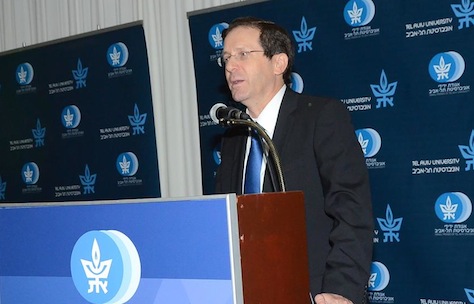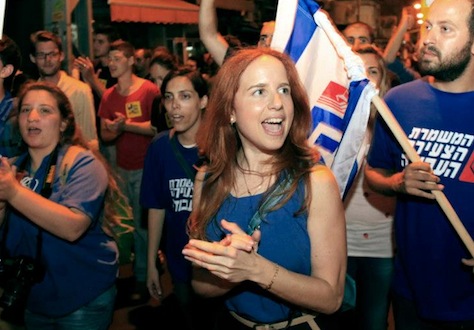As Israeli prime minister Benjamin Netanyahu travels to the United States to deliver a controversial address to the US Congress on Tuesday morning, he’ll leave behind him in Israel (if only for a couple of days) one of the toughest election campaigns of his career.![]()
The Washington speech has sucked up much of the attention from Israel’s election campaign, both in the United States and in Israel itself. But that doesn’t guarantee that Netanyahu will win what would be a fourth term as prime minister and his third consecutive term since returning to power in 2009.
Netanyahu’s center-right Likud (הַלִּכּוּד), consistently since December, has been tied in most polls with the Zionist Union (המחנה הציוני), a merger between the center-left Labor Party (מפלגת העבודה הישראלית) and a bloc of moderates led by former justice minister Tzipi Livni, herself the former leader of the late Ariel Sharon’s essentially defunct Kadima (קדימה, ‘Forward’).
Though Israeli politics has become a dizzying array of fragmented, personalized parties, where political leaders denounce opponents one day only to join forces with the same opponents the next, Herzog and Livni both support a more progression economic agenda as well as the ‘two-state’ solution to the Israeli-Palestinian conflict.
The Zionist Union’s combined support means that Labor’s newest leader, Isaac Herzog, has emerged as the top alternative to Netanyahu to become Israel’s next prime minister. A soft-spoken attorney, Herzog isn’t known for his charisma or his bluster, and his chief quality might be that he’s regarded as the quintessential anti-Netanyahu, at least in style.
So how did Herzog (pictured above) get to this point? And what would a Herzog-led government look like?
Herzog wants to end Labor’s wilderness period
Though the Labor Party hasn’t won an Israeli election since 1999, it nevertheless has a storied legacy — it’s the party of Golda Meir, of Yitzhak Rabin, of Shimon Peres. Herzog himself is the son of Israel’s sixth president, Chaim Herzog, and he studied in New York in the 1970s when his father was serving as Israel’s ambassador to the United Nations. Herzog is Labor’s fourth permanent leader in a decade, and he hopes to lead Labor to its most successful election victory since the 1999 parliamentary elections under former prime minister Ehud Barak.
Throughout several governments in the 2000s in which Labor served as a junior coalition partner, Herzog held a handful of portfolios, including housing, tourism and, ultimately, welfare and social services from 2007 to 2011.
Barak, who lost the premiership in 2001 to Sharon, regained the Labor Party leadership in 2007 and brought Labor into governing coalitions, first under Sharon’s protégé Ehud Olmert and, more controversially, under Netanyahu. As the Labor grassroots became increasingly unhappy about Labor’s coalition with Netanyahu, however, Barak not only resigned as Labor Party leader, but left the party altogether to remain in government as Netanyahu’s defense minister.
Herzog launched his first bid for the Labor leadership after Barak bolted in 2011. He finished, narrowly, in third place behind former leader Amir Peretz, who was seeking his own comeback, and the ultimate winner of the 2011 leadership race, Shelly Yachimovich.
Under Yachimovich, Labor emphasized domestic economic issues, including the rising prices, housing affordability and income inequality that gave rise to social protests across Israel in 2011. Though Labor gained two seats in the most recent January 2013 election, Herzog and others were unimpressed. He triggered a fresh leadership contest in November 2013 and unseated Yachimovich by a margin of 58% to 42%.
A Herzog government would bring a new generation of officials to power, including the 29-year-old Stav Shaffir (pictured above), a leader of the 2011 social justice protests and a voice for greater social welfare in the Israeli budget, and the 35-year old Itzik Shmuli, a popular (if more conventional) rising star. It would also include Livni and other familiar Labor faces, including Peretz, the Morocco-born former defense and deputy prime minister.
Herzog hasn’t exactly abandoned Yachimovich’s emphasis on social and economic equality, but he has been more vocal about foreign affairs. Although his positions on Palestine and Iran aren’t drastically different from Netanyahu’s, Herzog has sharply criticized Netanyahu for isolating Israel from its traditional allies, most especially the United States. Though Herzog would institute a freeze on building new settlements in the West Bank, he wouldn’t necessarily dismantle existing settlements.
Getting to 61
Though the Labor-Livni ‘Zionist Union’ is locked in a battle for first place with Likud, and though Herzog is gunning to pull soft Likud voters from Netanyahu, the two largest Israeli parties are really trying to maximize their vote share from two discrete pools of supporters.
Netanyahu, for his part, is trying to consolidate as much support as possible on the Israeli right. That means peeling votes away from the ultraorthodox haredim parties and from quasi-allies, including economy minister Naftali Bennett’s Bayit Yehudi (הבית היהודי, ‘The Jewish Home’), foreign minister Avigdor Lieberman’s Yisrael Beiteinu (ישראל ביתנו, ‘Israel is Our Home’) and the new party of former communications minister Moshe Kahlon, Kulanu (כולנו, ‘All of Us’).
Labor, for its part, hopes to pull away votes from the Arab nationalist parties, the Zionist leftist Meretz (מרצ, ‘Energy’) and from centrist parties like Kulanu and the party of former finance minister Yair Lapid, Yesh Atid (יש עתיד, ‘There is a Future’).
Though Herzog and the ‘Zionist Union’ could eke out the largest share of the vote on March 17, polls show that the broad Israeli right (including Likud and the nationalist, conservative and religious parties) is set to gain seats, in aggregate, at the expense of the broad left (including Labor and the other leftist and Arab nationalist parties).
Though Israel’s president, former Knesset speaker Reuven Rivlin, is well-respected as an even broker (and certainly no Netanyahu fan), Herzog may struggle to find a majoritarian coalition. If polls are correct, an alliance with Yesh Atid, Meretz and the Arab parties would fall far short of the 61 votes that he’d need for a majority in the 120-member Knesset.
That might be one reason why Herzog is apparently reaching out to the three major haredim parties, which could cumulatively win 16 to 19 seats and would prove much less controversial than a coalition that depends on the Arab parties (either inside or outside a formal coalition). A Labor-led coalition that includes the orthodox parties, plus Yesh Atid and Kulanu stands a far better chance of getting to 61 (or higher), and would probably be far more stable in government.
It wouldn’t necessarily be an easy path. Lapid and the haredim have significant differences, especially regarding the Tal Law, which provided an exemption to haredi students from service in the Israeli Defense Forces, until Israel’s Supreme Court invalidated it in December 2012. Kahlon’s supporters are essentially moderate Likudniks that have little in common with progressive populists like Shaffir and Shmuli. But Herzog’s gracious, understated manner could facilitate coalition-building, and the giddiness of toppling Netanyahu would initially bring together some odd bedfellows. Surprising Israeli coalitions have been built on far less in the past.

